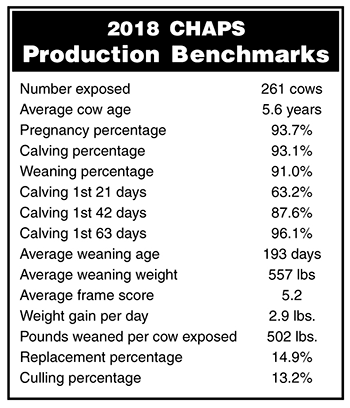
Kris Ringwall
Beef Talk
‘500 Club’ reached in 2018 cow-calf production benchmarks.
Commercial beef producers joined the “500 Club” in pounds weaned per cow exposed, according to the 2018 Cow Herd Appraisal Performance Software (CHAPS) records.
The new benchmark is 502 pounds (lb.) and illustrates better understanding of benchmarks. This knowledge is critical because it allows producers to gauge, adjust and keep track of cattle production based on long-term benchmarks within the industry.
You cannot change what you do not measure. Measurement of a trait through time helps make active decisions to lower, maintain or increase that trait within the herd. Begin by knowing the level at which the cow-calf enterprise is functioning.
The NDSU Dickinson Research Extension Center calculates yearly averages of beef cow herd data from producers. The CHAPS team calculates five-year rolling average benchmarks from herds with at least 50 cows that have been in CHAPS for three years or more. Yearly averages are good, but a rolling five-year average buffers yearly ups and downs in the data.

A review of the 2018 benchmarks is a worthy read because understanding normal, or in this case typical, performance allows producers to better understand how to set and guide individual herd goals. Overall reproductive traits, expressed in percentages of cows exposed, and some growth traits, expressed in pounds, are presented.
For the typical CHAPS producer, 93.7% of the cows exposed to bulls were pregnant in the fall, with 93.1% calving in the spring. In the fall, 91% of the cows that were exposed to bulls weaned a calf.
During a typical calving season, 63.2% calved during the first 21 days, 87.6% during the first 42 days and 96.1% within the first 63 days. The average age of the cows was 5.6 years.
Calf age, growth and weaning numbers were as follows: age, 193 days; weight, 557 lb.; and frame score, 5.2. The weight per day of age was 2.9 lb., and the average daily gain was 2.5 lb.
“Pounds weaned per cow exposed to the bull” is a trait that factors in management and genetics in cattle production. For every cow exposed, CHAPS producers weaned 502 lb. of calf.
Interestingly, benchmarks do not vary much across years, which is indicative of a mature cow-calf business. Because of the maturity of the cow-calf business, cattle producers have developed stable production practices that, in some cases, cross generations of beef producers.
Minor ups and downs may occur, but newsworthy changes are seldom. Some individual operations will experience what one might call “Mother Nature” trauma, but those operations have little they can do about those events, other than to have an emergency response plan in place. As an aside, that emergency response plan needs practice, so go over those plans at least once a year.
Back to the benchmarks. The good news, although small, is that pounds weaned per cow exposed benchmarks for 2018 reached the “500 Club,” with an average benchmark of 502 lb.
That’s good news because the industry has been on a five-year run of lower pounds weaned per cow exposed. That number was 499 lb. for 2013, 496 lb. for 2014, 495 lb. for 2015, 494 lb. for 2016, and 498 lb. for 2017. These may not seem like huge differences, but the trend is good.
Prior to that, the benchmark for pounds of calf weaned per cow exposed had been quite consistent. Historically (10-plus years ago), the benchmark was 500 lb. for 2005, and 502 lb. for 2006 and 2007. In 2008, the benchmark for pounds weaned per cow exposed was again at 500 lb., and it was at 507 lb. for 2009, 505 lb. for 2010, 503 lb. for 2011, and 501 lb. for 2012.
Interestingly, the average producer has not been able to sustain the 500-lb. threshold in recent years, so I guess we will wait to see if the “500 Club” pound mark holds.
Has the industry changed much? Not really. Is 500 lb. the right number? Well, each producer has to determine what fits the operation.
However, CHAPS has been calculating the number since the mid-1980s, and after many years of evaluations of CHAPS herds, 500 lb. is doable and a logical goal. A tweak could be that those producers with lower input may accept fewer pounds at weaning. Again, each producer needs to do what is right for that person’s operation and checkbook.
The discussion today is simply benchmarks. As stated earlier, benchmarks allow a producer to measure managerial changes on the operation.
Fall is a good time to review the status of the beef operation as the calves come home. Sitting on the fence and watching the cattle walk by is good, but numbers are needed to offer the details for a proper evaluation. Do you know your pounds of calf produced per cow exposed?
May you find all your ear tags.
Editor’s Note: Kris Ringwall is a beef specialist for the North Dakota State University Extension Service. For more information, contact your local NDSU Extension Service agent (https://www.ag.ndsu.edu/extension/directory) or Ringwall at the Dickinson Research Extension Center, 1041 State Ave., Dickinson, ND 58601; 701-456-1103; or kris.ringwall@ndsu.edu.







